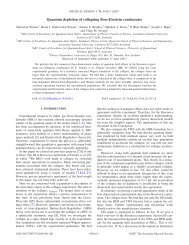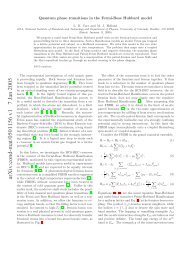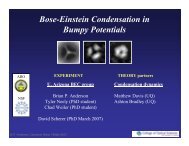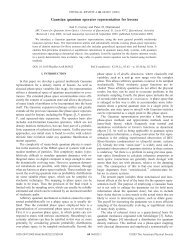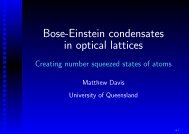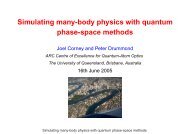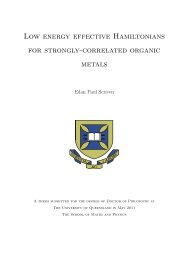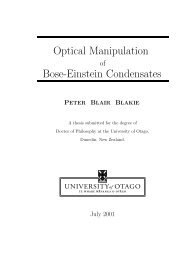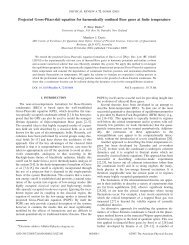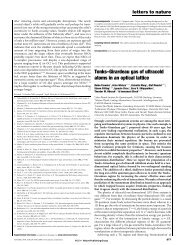Open Quantum Dynamics of Mesoscopic Bose-Einstein ... - Physics
Open Quantum Dynamics of Mesoscopic Bose-Einstein ... - Physics
Open Quantum Dynamics of Mesoscopic Bose-Einstein ... - Physics
You also want an ePaper? Increase the reach of your titles
YUMPU automatically turns print PDFs into web optimized ePapers that Google loves.
7. <strong>Quantum</strong> simulations <strong>of</strong> evaporatively cooled <strong>Bose</strong> condensates7.4.1 Constraints and limitationsIn practical computations, it is necessary to consider rather small traps. This is becausethe numerical lattice spacing used to sample the stochastic fields in x-space must be <strong>of</strong>order ∆x = 1/k max , where k max is the largest ordinary momentum considered in theproblem. However, the value <strong>of</strong> the corresponding kinetic energy, E K =(k max ) 2 /2m,must be large enough to allow energetic atoms to escape over the potential barrier <strong>of</strong> thetrap; otherwise no cooling can take place. This sets an upper bound on the lattice spacingand hence on the maximum trap size, which depends on the number <strong>of</strong> lattice points thatcan be computed.The available lattice sizes used here were 32 3 points in three dimensions and 64 2points in two dimensions. With this limit, and parameter values similar to those used inthe experiments, the available trap sizes that can be treated are <strong>of</strong> the order <strong>of</strong> microndimensions. These are smaller than those used currently, although traps <strong>of</strong> this type arequite feasible. The other possibility within the constraints is to use a trap which is <strong>of</strong> largerdimensions but lower in potential height. For this type <strong>of</strong> trap, which was simulated here,the width was L j =10µm, with a maximum potential height <strong>of</strong> V max /k B =1.9 × 10 −7 K,and an initial temperature <strong>of</strong> T 0 =2.4 × 10 −7 K.A further limitation is that the initial density must be such that 〈 n(k) 〉 1; otherwisethe gas would already be <strong>Bose</strong> condensed, with many particles in particular modes. Thisplaces a limit on the number <strong>of</strong> atoms which can simulated, if we assume an initiallynoncondensed grand canonical ensemble <strong>of</strong> (approximately) noninteracting atoms. Therewere initially around 500 atoms in the two-dimensional simulations presented here, and10, 000 in the three-dimensional case. These correspond to atomic densities <strong>of</strong> n 0 =5.0 ×10 12 /m 2 and n 0 =1.0 × 10 19 /m 3 respectively.However not all the lattice points that atoms can occupy are contained within the trap.Necessarily, some <strong>of</strong> the lattice points correspond to untrapped sites. The proportion <strong>of</strong>lattice sites that lie within the trap depends on the trapping potential. For the sinusoidaltrap in three dimensions, up to half the sites lie outside the trap, a result <strong>of</strong> embedding anapproximately spherical potential within a cubic lattice structure. The nonspherical trapV 3 defined in Eq. (7.5) overcomes this problem and confines more atoms. But in this casethe larger nonlinear terms, coupled with the stochastic terms, drive large excursions intophase space at long times. This causes the fields a j to vary significantly from one trajectory152



